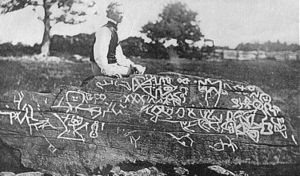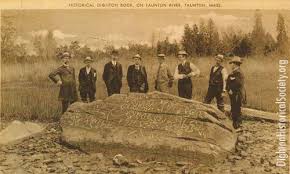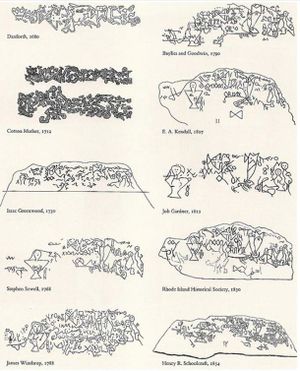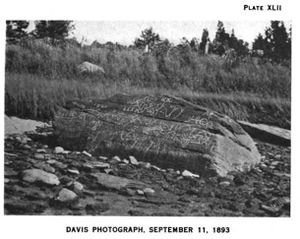Dighton Rock: Difference between revisions
Jump to navigation
Jump to search
No edit summary |
mNo edit summary |
||
| Line 4: | Line 4: | ||
1928, Dighton Rock: A Study of the Written Rocks of New England. Walter Neale, New York.</ref> in an area that was orignally occupied by the indigenous Wôpanâak people. <ref name ="nat geo">National Geographic Society | 1928, Dighton Rock: A Study of the Written Rocks of New England. Walter Neale, New York.</ref> in an area that was orignally occupied by the indigenous Wôpanâak people. <ref name ="nat geo">National Geographic Society | ||
N.d. Resource Library. Electronic Document, https://www.nationalgeographic.org/photo/wampanoag-territory/, accessed October 31, 2019.</ref><ref name="delabarre" /> Although modern archaeologists agree that the Dighton rock petroglyphs were probably inscribed by the indigenous people of the area, Dighton rock has been a source of controversy due to assertions by [https://en.wikipedia.org/wiki/Pseudoarchaeology pseudoarchaeologists] that it is evidence of pre-Columbian contact with indigenous nations in the Americas.<ref name ="feder">Feder, Kenneth L. | N.d. Resource Library. Electronic Document, https://www.nationalgeographic.org/photo/wampanoag-territory/, accessed October 31, 2019.</ref><ref name="delabarre" /> Although modern archaeologists agree that the Dighton rock petroglyphs were probably inscribed by the indigenous people of the area, Dighton rock has been a source of controversy due to assertions by [https://en.wikipedia.org/wiki/Pseudoarchaeology pseudoarchaeologists] that it is evidence of pre-Columbian contact with indigenous nations in the Americas.<ref name ="feder">Feder, Kenneth L. | ||
2010 Encyclopedia of Dubious Archaeology: From Atlantis To The Walam Olum. Greenwood, California.</ref>[[Image:Dighton rock (nonslutty version).jpg|thumb|right|options|Dighton rock and | 2010 Encyclopedia of Dubious Archaeology: From Atlantis To The Walam Olum. Greenwood, California.</ref>[[Image:Dighton rock (nonslutty version).jpg|thumb|right|options|Dighton rock and Seth Eastman, Henry Rowe Schoolcraft's illustrator<ref>New England Historical Society n.d. The Mystery of Dighton Rock – ‘No man alive knows…’. Electronic document, http://www.newenglandhistoricalsociety.com/the-mystery-of-dighton-rock-no-man-alive-knows/, accessed December 12, 2019.</ref>]] | ||
==What is Dighton Rock?== | ==What is Dighton Rock?== | ||
===Discovery=== | ===Discovery=== | ||
Revision as of 15:23, 13 December 2019
by Ayla Schwartz
Dighton Rock (see also, the Dighton Writing Rock, the Assonet Monument) is a petroglyphic boulder located in Massachusetts along the northwesternly corner of Assonet River[1] in an area that was orignally occupied by the indigenous Wôpanâak people. [2][1] Although modern archaeologists agree that the Dighton rock petroglyphs were probably inscribed by the indigenous people of the area, Dighton rock has been a source of controversy due to assertions by pseudoarchaeologists that it is evidence of pre-Columbian contact with indigenous nations in the Americas.[3]

What is Dighton Rock?
Discovery

Reception
Popular Press
Archaeological Community
Petroglyphs

Pseudoarchaeogical Narrative
Pre-Columbian Settlement of North America
An Archaeological Response
How the Archaeological Record Works
The Flaws and Inconsitancies in Pre-Columbian Contact "theories"
Dighton Rock as (bad) evidence

References
- ↑ 1.0 1.1 Delabarre, Edmund Burke 1928, Dighton Rock: A Study of the Written Rocks of New England. Walter Neale, New York.
- ↑ National Geographic Society N.d. Resource Library. Electronic Document, https://www.nationalgeographic.org/photo/wampanoag-territory/, accessed October 31, 2019.
- ↑ Feder, Kenneth L. 2010 Encyclopedia of Dubious Archaeology: From Atlantis To The Walam Olum. Greenwood, California.
- ↑ New England Historical Society n.d. The Mystery of Dighton Rock – ‘No man alive knows…’. Electronic document, http://www.newenglandhistoricalsociety.com/the-mystery-of-dighton-rock-no-man-alive-knows/, accessed December 12, 2019.